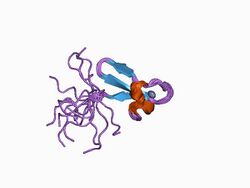Biology:Copper fist
| Copper fist domain | |||||||||||
|---|---|---|---|---|---|---|---|---|---|---|---|
 Structure of a zinc domain conserved in yeast copper-regulated transcription factors.[1] | |||||||||||
| Identifiers | |||||||||||
| Symbol | Copper fist | ||||||||||
| Pfam | PF00649 | ||||||||||
| InterPro | IPR001083 | ||||||||||
| SMART | SM00412 | ||||||||||
| PROSITE | PS50073 | ||||||||||
| SCOP2 | 1co4 / SCOPe / SUPFAM | ||||||||||
| |||||||||||
Copper fist is an N-terminal domain involved in copper-dependent DNA binding. It is named for its resemblance to a fist closed around a penny. Functionally, the "penny" is a collection of copper ions and the "knuckles" of the fist are proteins that interact with the promoter of the metallothionein gene,[1] enhancing its transcription by creating a more stable binding site for RNA polymerase during transcription, an essential step in DNA replication.[2]
Structure and function
The copper fist domain contains an array of zinc-binding polymers (Cys-X2-Cys-X8-Cys-X-His)[1] that form a three-stranded antiparallel β-sheet, a secondary protein structure composed of beta strands connected by hydrogen bonds,[3] with two short helical segments that protrude from the end of the β-sheet. One primary function of the copper fist domain is to maintain copper homeostasis. Copper is an essential trace element involved in various biological processes, including energy production, antioxidant defense, and the functioning of metalloenzymes; however, high levels of copper can be toxic to many organisms.[4]
Fungal transcription factors and metallothionein regulation
Another function of the copper fist domain is the activation and regulation of the metallothionein gene. Metallothionein, a type of protein that binds metal in cells,[5] is responsible for maintaining metal-based homeostasis, protecting from heavy metal toxicity, and oxidative stress.[6] The promoter of the metallothionein gene reacts with certain metals to achieve these properties.[7] The copper fist domain can be found in some fungal transcription factors (MAC1, Cuf1, AfMac1, Afu2g01190, Afu6g07780, etc.).[8]
The copper fist DNA binding domain of yeast and other fungi interacts with copper when it is encountered in excess, as high levels of copper can be very toxic to fungal cell walls and membranes.[2][9] The proteins of the domain proteins activate, improve, and stabilize the transcription of the metallothionein gene in response to copper ions.[10] The copper fist domain is similar in structure to metallothionein itself, and it undergoes a large conformational change upon binding to copper, which allows for the binding of DNA and the enhancement of the promoter region of the metallothionein gene.[1]
ACE1 and AMT1 are examples of copper fist fungal transcription factors. ACE1 can activate metallothionein to prevent the toxicity caused by excess copper.[11] AMT1 functions similarly in reducing potentially toxic copper levels.[12] MAC1 is another copper sensitive gene that is essential for both copper mediation and copper usage in yeast.[13]
References
- ↑ 1.0 1.1 1.2 1.3 "Solution structure of a zinc domain conserved in yeast copper-regulated transcription factors". Nature Structural Biology 5 (7): 551–555. July 1998. doi:10.1038/805. PMID 9665167.
- ↑ 2.0 2.1 "Addgene: Promoters". https://www.addgene.org/mol-bio-reference/promoters/#:~:text=DNA%20sequences%20called%20response%20elements,transcription%20of%20DNA%20into%20mRNA.
- ↑ "Secondary Structure Prediction". Encyclopedia of Bioinformatics and Computational Biology. Oxford: Academic Press. January 2019. pp. 488–496. doi:10.1016/B978-0-12-809633-8.20267-7. ISBN 978-0-12-811432-2.
- ↑ "The Candida glabrata Amt1 copper-sensing transcription factor requires Swi/Snf and Gcn5 at a critical step in copper detoxification". Molecular Microbiology 40 (5): 1165–1174. June 2001. doi:10.1046/j.1365-2958.2001.02458.x. PMID 11401720.
- ↑ "Chapter 2 - General Chemistry, Sampling, Analytical Methods, and Speciation". Handbook on the Toxicology of Metals (Fourth ed.). San Diego: Academic Press. January 2015. pp. 15–44. doi:10.1016/B978-0-444-59453-2.00002-0. ISBN 978-0-444-59453-2.
- ↑ "Origin, Function, and Fate of Metallothionein in Human Blood". Reviews of Physiology, Biochemistry and Pharmacology 173: 41–62. 2017. doi:10.1007/112_2017_1. ISBN 978-3-319-61366-6. PMID 28417197.
- ↑ "Activation of transcription by two factors that bind promoter and enhancer sequences of the human metallothionein gene and SV40". Nature 325 (6102): 368–372. January 28, 1987. doi:10.1038/325368a0. PMID 3027570.
- ↑ "Transcription factor Afmac1 controls copper import machinery in Aspergillus fumigatus". Current Genetics 63 (4): 777–789. August 2017. doi:10.1007/s00294-017-0681-z. PMID 28215034.
- ↑ "Effective induction of pblac1 laccase by copper ion in Polyporus brumalis ibrc05015". Fungal Biology 117 (1): 52–61. January 2013. doi:10.1016/j.funbio.2012.11.005. PMID 23332833.
- ↑ "Yeast copper-dependent transcription factor ACE1 enhanced copper stress tolerance in Arabidopsis". BMB Reports 42 (11): 752–757. November 2009. doi:10.5483/BMBRep.2009.42.11.752. PMID 19944018.
- ↑ "Expression of genes encoding laccase and manganese-dependent peroxidase in the fungus Ceriporiopsis subvermispora is mediated by an ACE1-like copper-fist transcription factor". Fungal Genetics and Biology 46 (1): 104–111. January 2009. doi:10.1016/j.fgb.2008.10.002. PMID 18955150.
- ↑ Thorvaldsen, J. L.; Sewell, A. K.; McCowen, C. L.; Winge, D. R. (1993-06-15). "Regulation of metallothionein genes by the ACE1 and AMT1 transcription factors". Journal of Biological Chemistry 268 (17): 12512–12518. doi:10.1016/S0021-9258(18)31418-2. ISSN 0021-9258.
- ↑ "MAC1, a nuclear regulatory protein related to Cu-dependent transcription factors is involved in Cu/Fe utilization and stress resistance in yeast". The EMBO Journal 12 (13): 5051–5056. December 1993. doi:10.1002/j.1460-2075.1993.tb06198.x. PMID 8262047.
 |

